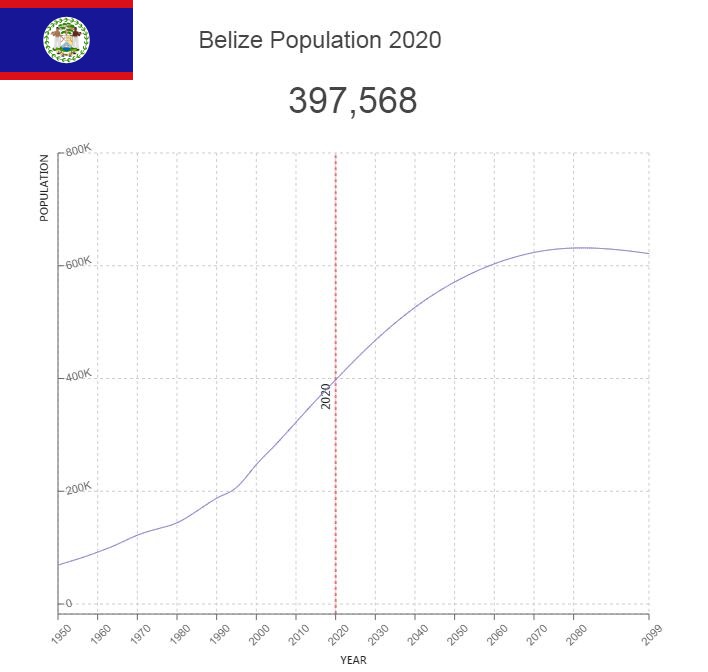Belize Population

Belize, located in Central America, has much in common with the island states of the Caribbean. Tourism is an important source of income for the country, which has one of the world’s largest coral reefs.
Key figures and facts
- Capital: Belmopan
- Ethnic groups: Fertilizer 52.9%, Creole 25.9%, Mayan Indians 11.3%, Garifuners 6.1%, others 11.2% (2010)
- Language: English 62.9% (official), Spanish 56.6%, Creole 44.6%, Mayan dialects 10.5%, German 3.2%, garifuna 2.9% (Caribbean), other 1.8%, unknown 0.5% (2010)
- Religion: Roman Catholic 40.1%, Protestants 31.5% (Pentecostals 8.4%, Seventh-day Adventists 5.4%, Anglicans 4.7%, Mennonites 3.7%, Methodists 2.9%), Jehovah’s Witnesses 1.7%, others 10.5%, none/unspecified 16.1% (2010)
- Population: 382 444 (2017)
- Area: 22 970 Km2
- Currency: Belizean dollar
- GNP per capita: 8 462 PPP $
- National Day: September 21st
Belize’s Population
The population of Belize is estimated at 331 900 (World Bank 2013), annual population growth of 2.4%. The highly heterogeneous population consists of about 25% Creole, which is particularly dominant in Belize City, the former capital, approximately 50% mastics and 11% Mayan Indians. A special group is the Garifuna (6%), descendants of slaves combined with Caribbean Indians from the island of Saint Vincent who were deported by the British to the Bay Islands outside Honduras in 1797. The population density is low with an average of approximately 14.6 people per km². The coastal areas are most densely populated. Only major city is Belize City with 49,050 inbound (2000). The capital is Belmopan with 8100 residents (2002).
Population of Belize by Year (Historical)
| Year | Population | Annual Growth Rate | Population Density | Global Rank |
| 2020 | 397,517 | 1.860% | 17.4322 | 177 |
| 2019 | 390,242 | 1.900% | 17.1132 | 177 |
| 2018 | 382,960 | 1.940% | 16.7940 | 178 |
| 2017 | 375,658 | 2.000% | 16.4739 | 179 |
| 2016 | 368,289 | 2.070% | 16.1508 | 179 |
| 2015 | 360,822 | 2.280% | 15.8234 | 179 |
| 2010 | 322,353 | 2.590% | 14.1370 | 179 |
| 2005 | 283,689 | 2.790% | 12.4419 | 180 |
| 2000 | 247,204 | 3.630% | 10.8424 | 181 |
| 1995 | 206,852 | 1.990% | 9.0733 | 182 |
| 1990 | 187,441 | 2.610% | 8.2224 | 182 |
| 1985 | 164,810 | 2.730% | 7.2302 | 182 |
| 1980 | 144,044 | 1.580% | 6.3198 | 185 |
| 1975 | 133,149 | 1.750% | 5.8422 | 182 |
| 1970 | 122,071 | 2.860% | 5.3565 | 180 |
| 1965 | 106,008 | 2.880% | 4.6523 | 180 |
| 1960 | 91,953 | 2.880% | 4.0361 | 179 |
| 1955 | 79,759 | 2.990% | 3.5015 | 180 |
| 1950 | 68,808 | 0.000% | 3.0214 | 182 |
Major Cities in Belize by Population
| Rank | City | Population |
| 1 | Belize City | 61,350 |
| 2 | San Ignacio | 16,701 |
| 3 | Orange Walk | 15,187 |
| 4 | Belmopan | 13,270 |
| 5 | Dangriga | 10,639 |
| 6 | Corozal | 9,760 |
| 7 | San Pedro | 8,307 |
| 8 | Benque Viejo el Carmen | 6,981 |
| 9 | Punta Gorda | 5,094 |
Religion
About 58% of the population is Catholic, approximately 7% Anglicans, approximately 4.5% Methodists, approximately 4% Mennonites, Pentecostals 6.3% and Seventh-day Adventists 4.1%. In addition, there are minorities of Muslims, Hindus, Jews and Bahai.
Language
The official language is English. English Creole and Spanish are widely used as a spoken language. The Indians speak Mayan or other Native American languages.













































